10 things you should know before traveling to Colombia
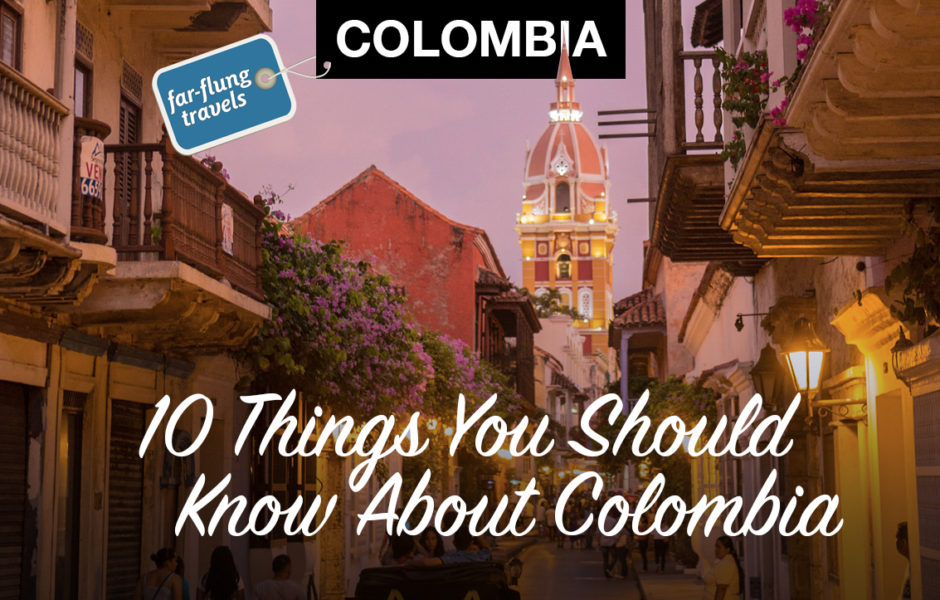
I’ve been traveling to Colombia for nearly a decade. Each time I visit the South American country, I find more and more things to do—and things to love about it. Bogotá, Medellín and Cartagena are the most popular Colombian destinations, but there’s so much more unforgettable travel experiences throughout the country: the coffee region, Tayrona National Park, the Rosario Islands, the colorful towns of Antioquia and the list goes on and on.
Colombia has it all — sparkling coastline (both Caribbean and Pacific), mountain peaks, lush jungle, high-energy nightlife, amazing food and the some of the friendliest people I’ve ever met. If you have any reservations about visiting Colombia, here are some things you should know. Hopefully some of these facts will help you decide to book a flight, a hotel and tours for a trip to Colombia right now.
1. Colombia is generally safe to visit.
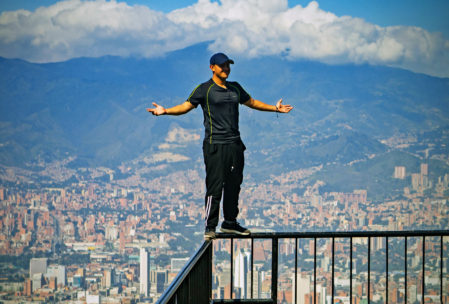
A daredevil perches on the edge of a cliff along a section of the Camino de la Vida, a walking path high above Medellín.
One of the first questions people ask me is whether it’s safe to visit Colombia. There was a time when travelers avoided the country, which was enveloped in a conflict between the Colombian government, paramilitary groups, crime syndicates and far-left guerillas, such as FARC and ELN. On June 23, 2016, the Colombian government and FARC rebels signed a historic peace deal, bringing them closer to ending the conflict. While there are still pockets of no-go places in Colombia, there’s no reason to avoid a trip to Colombia because of potential violence. Having said that, it’s always important to be exercise caution no matter where you go, whether it’s Colombia or your own city. Consider purchasing travel insurance from reputable companies like World Nomads or Allianz. For the most up-to-date travel advisories, visit the U.S. State Department’s Colombia Travel Advisory page.
2. Colombia is incredibly diverse.

One of the many swimming holes and waterfalls in the Antioquia region — this one near San Rafael.
Colombia, considered the gateway to South America, is the continent’s fourth largest country, which is divided into five distinct regions. It’s the only South American country that can boast both Caribbean and Pacific coastlines. The Eastern Plains of the Orinoco River basin give way to the soaring peaks and deep valleys of the Andes Mountains. And to the southeast, the lush and steamy Amazon region teems with exotic flora and fauna, from the pink river dolphin to lazy sloths.
3. You can’t possibly see and do everything in one visit.
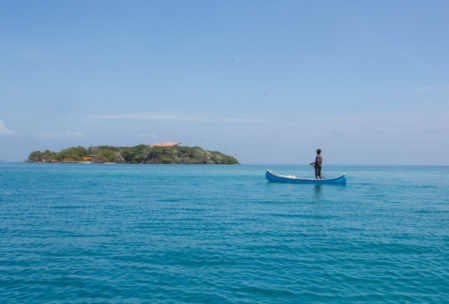
Located off the coast of Cartagena, the Rosario Islands are considered a Caribbean paradise. A boat is necessary to travel between the 20 islands —some of them just large enough for a house.
It’s impossible to plan a trip to Colombia and expect you can see and do it all in a week or even a month. Because it’s a big country with distinct regions, it may make more sense to arrive in one city and leave from another. Cartagena, Bogotá, Medellín and Cali all have airports with international arrivals. Domestic flights within the country are frequent and inexpensive.
4. Colombia has some of the best cuisine in Latin America.
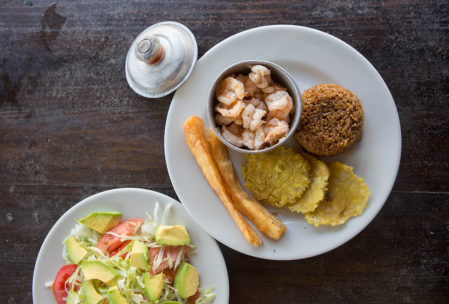
Coastal delights include shrimp with coconut rice, tostones (fried plantains), yucca and avocado salad.
Where do I start? Colombia has a wealth of flora and fauna that contribute to the wide variety of dishes founds in Colombia. If there were a national dish, it might be ajiaco (get my recipe for the hearty chicken soup here), or perhaps sancocho (a hearty stew made with either seafood or meat), or the ever-present arepa, a corn pancake that is served at any meal of the day. Wash it all down with a limonada de coco (the coconut limeaid recipe can be found here).
Colombian cuisine varies in preparation and ingredients by region and, in many cases, represents a fusion of native traditions blended with Spanish and African influences. You won’t go hungry when you have so many flavorful dishes from which to choose.
And don’t shy away from the street food. You can easily get your fill of delicious treats as you wander some of Colombia’s neighborhoods. An arepa with cheese, please? Perhaps, I’ll have the oblea (a wafer with dulce de leche and fresh cheese). Or how about a buñuelo (cheese fritter) or a paleta (frozen fruit juice bar)?
5. You can safely drink the water in Colombia’s major cities.

Pour yourself a tall drink of water to quench your thirst in Colombia’s major cities.
The traveler’s rule of thumb is to never to drink the water unless you want to find yourself curled up on the bathroom floor somewhere. So, it may come as surprise to know that you can safely skip the bottled water in the cities of Bogotá, Medellín, Cartagena and Cali. The municipal water is treated and you can drink straight from the tap.
Here’s a tip, though: While I will drink the water straight up, I prefer to boil the water, then put it in the fridge to cool overnight in a refillable stainless steel bottle. It makes me feel a little better that there’s a little less plastic polluting the environment.
6. Colombia is kid friendly.
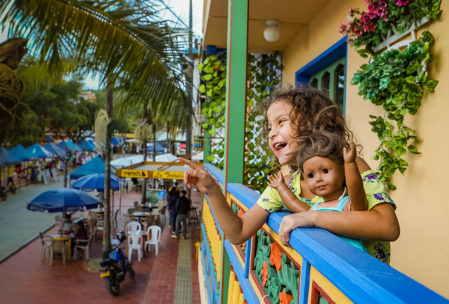
There’s no shortage of things to see and do when you’re traveling with kids in Colombia. Here, my daughter plays with her doll on a balcony overlooking Guatapé’s town square.
Colombians put family first and if you have children, they get preferential treatment from the moment you step off the plane and into the separate immigration queue for families traveling with kids. There’s no shortage of places that cater to families, whether it’s a shopping center with a kiddie park in the center (El Tesoro in Medellín), a restaurant with its own petting zoo and workshops for kids while you wait for lunch (La Granja Tenjo near Bogotá) and the Caribbean beaches are always a win. When it comes to lodging, I’ve stayed in some great apartment hotels that I’ve found on Booking.com. I always look for one that has a pool and is close to a supermarket and bus stop.
7. Colombia has two seasons.
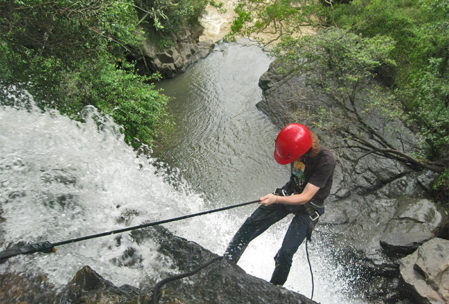
Abundant rainfall in the Antioquia region feed the rivers and waterfalls. Here, we are rappelling down a waterfall just outside of Villa de Lleyva.
Unlike the United States, which has the four seasons, Colombia has a rainy season and a dry season. While the seasons can vary dramatically, the rainy season typically hits April to May and October to November. Meanwhile, December to March and June to September are considered dry season months.
So, when is the best time to visit Colombia? Any time, although it also depends on where you want to go. You may not appreciate the rain if you’re visiting the Caribbean Coast, but other places, like Antioquia, the Amazon and the Pacific Coast experience rain showers all year round, which is why they are always lush and green. Don’t let a little rain stop you from visiting—just bring an umbrella.
There are a few spots that you may want to time just right. For example, the only way to see Caños Cristales’ explosion of color is from June to November.
8. Colombia’s coffee culture is a relatively new thing.
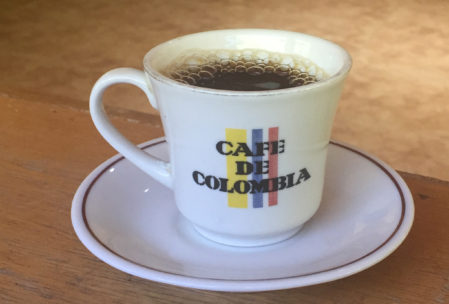
A good cup of joe is easier to come by these days. Traditionally, Colombians drink hot chocolate, aguapanela or fruit juices for breakfast.
Since the 1950s, the fictional Juan Valdez has helped cement Colombia’s image as a coffee-lover’s paradise. Sure, the country grows amazing coffee, but its internal coffee consumption lags behind places like the United States and Europe. Most of the good coffee has traditionally been sent abroad, while the home brew is an inferior water-down tinto. Instead of coffee for breakfast, Colombians prefer hot chocolate, panela or fruit juices. The influx of tourists to Colombia has spurring the demand for a good cup of coffee within the country and there are entrepreneurs stepping up to serve it. At the same time, Colombians are now clamoring for a better brew. You’ll find decent coffee shops, such as the Tostao chain, all over the country or head into the coffee region for a fresh cup on a coffee farm.
8. You don’t need to know Spanish, but it helps.
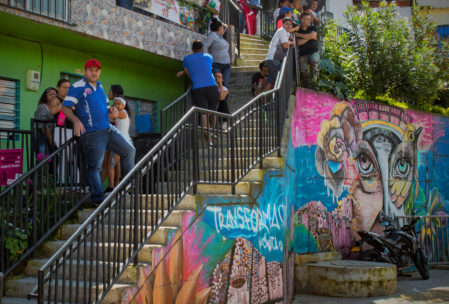
One of the most dangerous communities in Medellín has undergone an impressive transformation. The best way to learn about it is by taking a tour guided by a local, who has experienced the change first-hand.
Another question I often get is whether it’s important to know Spanish to travel to Colombia. Most hotels and tour operators in major cities and tourist zones will be able to communicate in English. That said, knowing the local language opens doors and makes experiences richer. Even learning a few phrases in Spanish will help. It’s also fun to learn local expressions and slang you here along the way. While in Medellín, I learned a verb that only the locals will understand (read the story here).
9. There’s more to Colombia than Pablo Escobar and drugs.
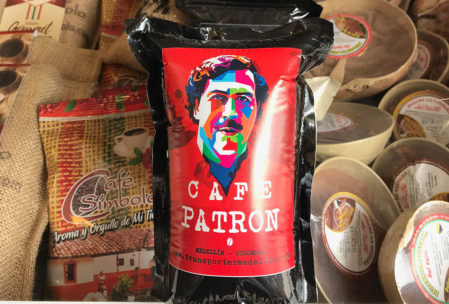
A souvenir shop at La Piedra de Peñol sells coffee emblazoned with Pablo Escobar’s face. While some are trying to capitalize on Escobar-inspired tourism, most Colombians find it distasteful.
Safety in Colombia has improved dramatically in the quarter century since it was considered one of the most dangerous city’s in the world due to civil unrest and gang-related activity connected to the cocaine trade. However, Pablo Escobar, the notorious drug lord who met his end on a Medellín rooftop in 1993, remains a larger-than-life figure has inspired a genre of travel called “Narco Tourism” fueled in part by the Netflix series “Narcos.” It’s not uncommon to find merchandise, from t-shirts to coffee, branded with Escobar’s face.
For many local people who lived through the violent era, narco tours are offensive for glorifying a really bad guy. The drug trade tore families apart and sometimes wiped them out completely. One person told me, “Everyone was affected in some way, but we want to move on.” So take my word for it, don’t ask random locals where you can score drugs and don’t assume locals approve of Escobar’s continuing legacy.
10. There’s a mobile-phone app for just about anything you’ll need to make your trip to Colombia easier.
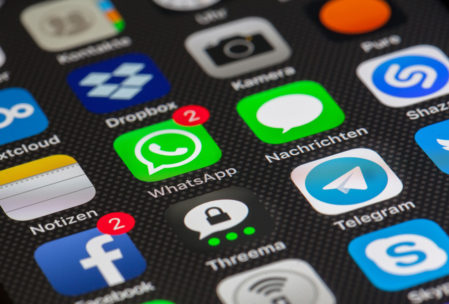
Mobile-phone applications make it easier to travel in Colombia.
Want to make life easier when you’re traveling to Colombia? The on-demand business models pioneered by companies like Uber, have made it easier than every to get somewhere in Colombia — or have something delivered to you. Make sure you download these apps before you arrive:
Communication in Colombia:
WhatsApp is used by travelers and locals to text, call or video anyone in the world for free. (iPhone or Android)
Transportation in Colombia:
Uber is an ever-present cash-free option for getting around, but Easy Taxi recently merged with Colombia’s secure-taxi app called Tappsi to try to take some of Uber’s marketshare.
Moovit helps users try to find the most convenient bus routes in real time. It works in 12 cities in Colombia.
On-demand delivery in Colombia:
While there are other on-demand delivery apps that work in Colombia, Rappi launched in 2018 and is quickly becoming a tech giant. Couriers will bring everything from takeout and groceries to medicine and office supplies right to your door. It’s perfect for when mom and dad want a late-night snack after the little ones are fast asleep.
You’re never going to want to leave.
Colombia will surprise you. It’s a magical destination with so many things to do and experiences to have. The tourism board had it right when they came up with the slogan, “The only risk is wanting to stay.”
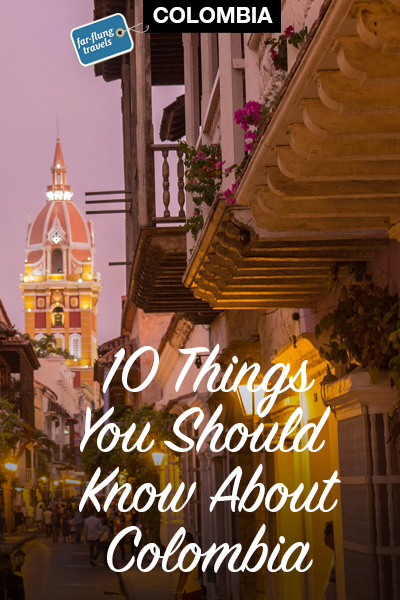
Pin this! http://www.farflungtravels.com/10-things-you-should-know-before-travel-to-colombia/
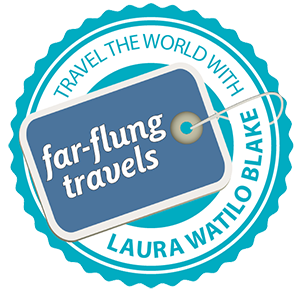

Comments